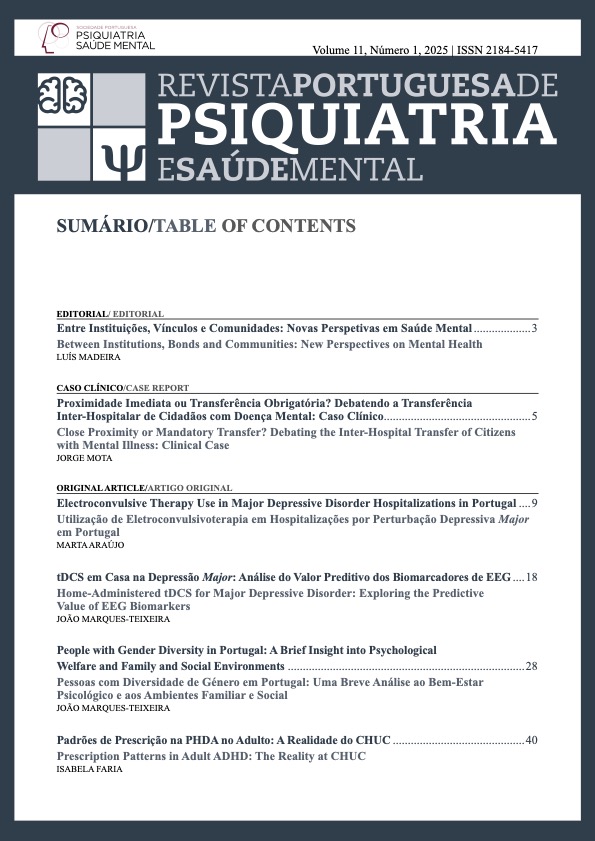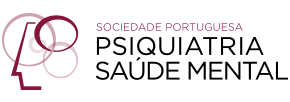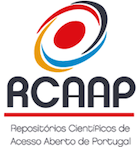Home ‑Administered tDCS for Major Depressive Disorder: Exploring the Predictive Value of EEG Biomarkers
DOI:
https://doi.org/10.51338/rppsm.598Keywords:
Biomarkers, Depressive Disorder, Major/therapy, Electroencephalography, Transcranial Magnetic StimulationAbstract
Introduction: Major depressive disorder (MDD) is a highly prevalent condition with a significant treatment‑resistant population. Transcranial direct current stimulation (tDCS) has emerged as a promising non‑invasive treatment, but biomarkers to predict its efficacy are needed. This study aimed to evaluate the feasibility and effectiveness of home‑administered tDCS in treating MDD and investigate frontal alpha asymmetry (FAA) as a predictor of treatment response.Methods: A total of 35 patients diagnosed with MDD underwent a four‑week tDCS treatment. Depression severity was measured using the PHQ‑9 scale, and FAA was calculated from EEG recordings. Paired t‑tests and Pearson correlation were used to analyze changes in depression scores and FAA, while logistic regression assessed FAA’s predictive value for treatment response.
Results: Sixty percent of patients showed improvement in depression symptoms post‑treatment, with 63% classified as responders. Significant changes in FAA were observed in responders (p<0.05), and a strong positive correlation was found between FAA changes and reductions in depressive symptoms (r= 0.63). Pre‑treatment FAA was a significant predictor of treatment response (p<0.05), with higher FAA values associated with a lower probability of response.
Conclusion: Home‑administered tDCS is an effective intervention for MDD, with FAA emerging as a valuable biomarker for predicting treatment response. These findings support the use of FAA in personalizing tDCS treatment for MDD.
Downloads
References
Chaudhari KS, Dhapkas MP, Kumar A, Ingle RG. Mental Disorders – A Serious Global Concern that Needs to Address. International Journal of Pharmaceutical Quality Assurance. 2024;15:973–8.
World Health Organization. Depression: let’s talk” says WHO, as depression tops list of causes of ill health. 2017.
Li S, Zhang X, Cai Y, Zheng L, Pang H, Lou L. Sex difference in incidence of major depressive disorder: an analysis from the Global Burden of Disease Study 2019. Ann Gen Psychiatry. 2023;22:53.
Loo CK, Alonzo A, Martin D, Mitchell PB, Galvez V, Sachdev P. Transcranial direct current stimulation for depression: 3-week randomised sham-controlled trial. Brit J Psychiat. 2012;200:52-9.
Brunoni AR, Moffa AH, Fregni F, Palm U, Padberg F, Blumberger DM, et al. Transcranial direct current stimulation for acute major depressive episodes: meta-analysis of individual patient data. Brit J Psychiat. 2016;208:522-31.
Shiozawa P, Fregni F, Benschor IM, Lotufo PA, Berlim MT, Daskalakis ZJ, et al. Transcranial direct current stimulation for major depression: an updated systematic review and meta-analysis. Int J Neuropsychopharmacol. 2014;17(9):1443-52.
Jog MV, Wang DJJ, Narr KL. A review of transcranial direct current stimulation (tDCS) for the individualized treatment of depressive symptoms. Pers Med Psychiatry. 2019;17-18:17-22.
Davidson RJ. Anterior cerebral asymmetry and the nature of emotion. Brain Cogn. 1992;20:125-51.
Davidson RJ. What does the prefrontal cortex “do” in affect: perspectives on frontal EEG asymmetry research. Biol Psychol. 2004;67:219-33.
Coan JA, Allen JJ. Frontal EEG asymmetry as a moderator and mediator of emotion. Biol Psychol. 2004;67:7-49.
Gordon R, Rzempoluck EJ. Introduction to Laplacian montages. Am J Electroneurodiagnostic Technol. 2004;44:98-102.
Velo JR, Stewart JL, Hasler BP, Towers DN, Allen JJB. Should it matter when we record? Time of year and time of day as factors influencing frontal EEG asymmetry. Biol Psychol. 2012;91:283-91.
Palm U, Hasan A, Strube W, Padberg F. tDCS for the treatment of depression: a comprehensive review. Eur Arch Psychiatry Clin Neurosci. 2016;266:681-94.
Fried PJ, Santarneechi E, Antal A, Bartres-Faz D, Bestmann S, Carpenter LL, et al. Training in the practice of noninvasive brain stimulation: Recommendations from an IFCN committee. Clin Neurophysiol. 2021;132:819-37.
Kroenke K, Spitzer RL, Williams JBW. The PHQ-9: Validity of a Brief Depression Severity Measure. J Gen Intern Med. 2001;16:606-13.
Lowe B, Unützer J, Callahan CM, Perkins AJ, Kroenke K. Monitoring depression treatment outcomes with the Patient Health Questionnaire-9. Med Care. 2004;42:1194-201.
Kounali D, Button KS, Lewis G, Gilbody S, Kessler D, Araya R, et al. How much change is enough? Evidence from a longitudinal study on depression in UK primary care. Psychol Med. 2022;52:1875-82.
Gollan JK, Hoxha D, Chihade D, Pflieger ME, Rosebrock L, Cacioppo J. Frontal alpha EEG asymmetry before and after behavioral activation treatment for depression. Biol Psychol. 2014;99:198-208.
Keeser D, Meindl T, Bor J, Palm U, Pogarell O, Mulert C, et al. Prefrontal transcranial direct current stimulation changes connectivity of resting-state networks during fMRI. J Neurosci. 2011;31:15284-93.








